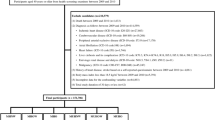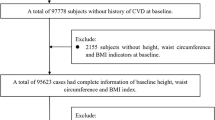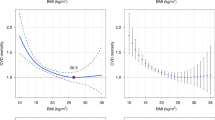Abstract
Background/Objectives
We investigated the hazards of cardiovascular diseases (CVDs) and all-cause death during follow-up according to baseline body mass index (BMI) and percent change in BMI among adults with insulin-treated diabetes.
Subjects/Methods
Using the Korean National Health Insurance Service datasets (2002–2017), the hazards of myocardial infarction (MI), stroke, and all-cause mortality during follow-up were analyzed according to baseline BMI and percent change in BMI among adults with insulin-treated diabetes and without baseline CVD and/or malignancy (N = 44,055).
Results
At baseline, 67.3% of total subjects were either obese or overweight. During a mean 3.8 years, 1,081 MI and 1,562 stroke cases developed; 2,847 deaths occurred over a mean 3.9 years. Compared with normal weight, overweight and obesity were associated with lower hazards of outcomes [hazard ratio (95% CI): 0.836 (0.712–0.981), 0.794 (0.687–0.917) for MI; 0.829 (0.726–0.946), 0.772 (0.684–0.870) for stroke; 0.740 (0.672–0.816), 0.666 (0.609–0.728) for death, respectively]. Underweight was associated with a higher hazard of all-cause death during follow-up [hazard ratio (95% CI): 2.035 (1.695–2.443)]. When the group with minimum absolute value for percent change in BMI was set as a reference, the relative reduction in BMI was associated with increased hazards of MI, stroke, and all-cause death, and relative increase in BMI was associated with increased hazards of stroke and all-cause death during follow-up.
Conclusions
Among adults with insulin-treated diabetes, a high prevalence of overweight and obesity was observed, and baseline BMI category was inversely associated with CVD incidence and all-cause death during follow-up. Both weight loss and gain were associated with increased CVD incidence and all-cause death during follow-up, showing a U-shaped relationship between weight change and outcome. Stable body weight might be a predictor of a lower risk of CVDs and premature death among individuals with insulin-treated diabetes.
This is a preview of subscription content, access via your institution
Access options
Subscribe to this journal
Receive 12 print issues and online access
$259.00 per year
only $21.58 per issue
Buy this article
- Purchase on Springer Link
- Instant access to full article PDF
Prices may be subject to local taxes which are calculated during checkout


Similar content being viewed by others
References
Lind M, Svensson AM, Kosiborod M, Gudbjörnsdottir S, Pivodic A, Wedel H, et al. Glycemic control and excess mortality in type 1 diabetes. N Engl J Med. 2014;371:1972–82.
Tancredi M, Rosengren A, Svensson AM, Kosiborod M, Pivodic A, Gudbjörnsdottir S, et al. Excess mortality among persons with type 2 diabetes. N Engl J Med. 2015;373:1720–32.
Gagnum V, Stene LC, Leivestad T, Joner G, Skrivarhaug T. Long-term mortality and end-stage renal disease in a type 1 diabetes population diagnosed at age 15-29 years in norway. Diabetes Care. 2017;40:38–45.
Lee YB, Han K, Kim B, Lee SE, Jun JE, Ahn J, et al. Risk of early mortality and cardiovascular disease in type 1 diabetes: a comparison with type 2 diabetes, a nationwide study. Cardiovasc Diabetol. 2019;18:157.
Svane J, Lynge TH, Pedersen-Bjergaard U, Jespersen T, Gislason GH, Risgaard B, et al. Cause-specific mortality in children and young adults with diabetes mellitus: a Danish nationwide cohort study. Eur J Prev Cardiol. 2019:2047487319836550.
Edqvist J, Rawshani A, Adiels M, Bjorck L, Lind M, Svensson AM, et al. BMI, mortality, and cardiovascular outcomes in type 1 diabetes: findings against an obesity paradox. Diabetes Care. 2019;42:1297–304.
Kilpatrick ES, Rigby AS, Atkin SL. Insulin resistance, the metabolic syndrome, and complication risk in type 1 diabetes: “double diabetes” in the Diabetes Control and Complications Trial. Diabetes Care. 2007;30:707–12.
Conway B, Miller RG, Costacou T, Fried L, Kelsey S, Evans RW, et al. Adiposity and mortality in type 1 diabetes. Int J Obes. 2009;33:796–805.
Lee Y-B, Han K, Kim B, Jin S-M, Lee S-E, Jun JE, et al. High proportion of adult cases and prevalence of metabolic syndrome in type 1 diabetes mellitus population in Korea: a nationwide study. Diabetes Metab J. 2019;43:76–89.
WHO expert consultation. Appropriate body-mass index for Asian populations and its implications for policy and intervention strategies. Lancet. 2004;363:157–63.
Lavie CJ, Milani RV, Ventura HO. Obesity and cardiovascular disease: risk factor, paradox, and impact of weight loss. J Am Coll Cardiol. 2009;53:1925–32.
Lavie CJ, Milani RV, Ventura HO. Obesity and the “obesity paradox” in cardiovascular diseases. Clin Pharmacol Ther. 2011;90:23–5.
Carnethon MR, Rasmussen-Torvik LJ, Palaniappan L. The obesity paradox in diabetes. Curr Cardiol Rep. 2014;16:446.
Vestberg D, Rosengren A, Olsson M, Gudbjörnsdottir S, Svensson AM, Lind M. Relationship between overweight and obesity with hospitalization for heart failure in 20,985 patients with type 1 diabetes: a population-based study from the Swedish National Diabetes Registry. Diabetes Care. 2013;36:2857–61.
Cheol Seong S, Kim YY, Khang YH, Heon Park J, Kang HJ, Lee H, et al. Data resource profile: the national health information database of the national health insurance service in South Korea. Int J Epidemiol. 2017;46:799–800.
Lee YB, Kim DH, Kim SM, Kim NH, Choi KM, Baik SH, et al. Hospitalization for heart failure incidence according to the transition in metabolic health and obesity status: a nationwide population-based study. Cardiovasc Diabetol. 2020;19:77.
Lee YH, Han K, Ko SH, Ko KS, Lee KU. Data analytic process of a nationwide population-based study using national health information database established by national health insurance service. Diabetes Metab J. 2016;40:79–82.
Lee YB, Han K, Kim B, Choi MS, Park J, Kim M, et al. Risk of early mortality and cardiovascular disease according to the presence of recently diagnosed diabetes and requirement for insulin treatment: A nationwide study. J Diabetes Investig. 2021. https://doi.org/10.1111/jdi.13539. (Online ahead of print).
Kim MK, Han K, Koh ES, Kim ES, Lee MK, Nam GE, et al. Blood pressure and development of cardiovascular disease in Koreans with type 2 diabetes mellitus. Hypertension. 2019;73:319–26.
Kim MK, Han K, Kim HS, Park YM, Kwon HS, Yoon KH, et al. Cholesterol variability and the risk of mortality, myocardial infarction, and stroke: a nationwide population-based study. Eur Heart J. 2017;38:3560–6.
Bahk J, Kim YY, Kang HY, Lee J, Kim I, Lee J, et al. Using the national health information database of the national health insurance service in Korea for monitoring mortality and life expectancy at national and local levels. J Korean Med Sci. 2017;32:1764–70.
Lee YB, Han K, Kim B, Jun JE, Lee SE, Ahn J, et al. Risk of end-stage renal disease from chronic kidney disease defined by decreased glomerular filtration rate in type 1 diabetes: a comparison with type 2 diabetes and the effect of metabolic syndrome. Diabetes Metab Res Rev. 2019;35:e3197.
Roh E, Hwang SY, Kim JA, Lee YB, Hong SH, Kim NH, et al. Body weight variability increases dementia risk among older adults: a nationwide population-based cohort study. Front Endocrinol. 2020;11:291.
Park S, Jeon SM, Jung SY, Hwang J, Kwon JW. Effect of late-life weight change on dementia incidence: a 10-year cohort study using claim data in Korea. BMJ Open. 2019;9:e021739.
Mühlhauser I, Overmann H, Bender R, Jörgens V, Berger M. Predictors of mortality and end-stage diabetic complications in patients with Type 1 diabetes mellitus on intensified insulin therapy. Diabet Med. 2000;17:727–34.
Roy M, Rendas-Baum R, Skurnick J. Mortality in African-Americans with Type 1 diabetes: The New Jersey 725. Diabet Med. 2006;23:698–706.
Lee S, Park HS, Kim SM, Kwon HS, Kim DY, Kim DJ, et al. Cut-off points of waist circumference for defining abdominal obesity in the Korean population. J Obes Metabolic Syndrome. 2006;15:1–9.
Kwon Y, Kim HJ, Park S, Park YG, Cho KH. Body mass index-related mortality in patients with type 2 diabetes and heterogeneity in obesity paradox studies: a dose-response meta-analysis. PLoS ONE. 2017;12:e0168247.
Doehner W, Gerstein HC, Ried J, Jung H, Asbrand C, Hess S, et al. Obesity and weight loss are inversely related to mortality and cardiovascular outcome in prediabetes and type 2 diabetes: data from the ORIGIN trial. Eur Heart J. 2020;41:2668–77.
Zoppini G, Verlato G, Leuzinger C, Zamboni C, Brun E, Bonora E, et al. Body mass index and the risk of mortality in type II diabetic patients from Verona. Int J Obes Relat Metab Disord. 2003;27:281–5.
Gallagher D, Visser M, Sepúlveda D, Pierson RN, Harris T, Heymsfield SB. How useful is body mass index for comparison of body fatness across age, sex, and ethnic groups? Am J Epidemiol. 1996;143:228–39.
Camhi SM, Bray GA, Bouchard C, Greenway FL, Johnson WD, Newton RL, et al. The relationship of waist circumference and BMI to visceral, subcutaneous, and total body fat: sex and race differences. Obesity. 2011;19:402–8.
Després JP, Couillard C, Gagnon J, Bergeron J, Leon AS, Rao DC, et al. Race, visceral adipose tissue, plasma lipids, and lipoprotein lipase activity in men and women: the Health, Risk Factors, Exercise Training, and Genetics (HERITAGE) family study. Arterioscler Thromb Vasc Biol. 2000;20:1932–8.
Purnell JQ, Braffett BH, Zinman B, Gubitosi-Klug RA, Sivitz W, Bantle JP, et al. Impact of Excessive Weight Gain on Cardiovascular Outcomes in Type 1 Diabetes: Results From the Diabetes Control and Complications Trial/Epidemiology of Diabetes Interventions and Complications (DCCT/EDIC) Study. Diabetes Care. 2017;40:1756–62.
Acknowledgements
This work was performed using the database from the Korean National Health Insurance Service (KNHIS). This study used the National Health Information Database constructed by the KNHIS, and the study results do not necessarily represent the opinion of the KNHIS.
Author information
Authors and Affiliations
Contributions
Y-BL drafted the manuscript. Y-BL, KH, GK, and JHK contributed to the study design. BK and KH participated in the data analysis planning and statistical analysis. JP, MK, MSC, SMJ, and KYH performed literature searches and contributed to conception of the hypothesis. JHK critically edited the manuscript. All authors read and approved the final version of the manuscript. JHK and KH are the guarantors of this work and, as such, had full access to all the data in the study and take responsibility for the integrity of the data and the accuracy of the data analysis.
Corresponding authors
Ethics declarations
Competing interests
The authors declare no competing interests.
Additional information
Publisher’s note Springer Nature remains neutral with regard to jurisdictional claims in published maps and institutional affiliations.
Supplementary information
Rights and permissions
About this article
Cite this article
Lee, YB., Kim, B., Park, J. et al. Early mortality and cardiovascular disease, varied association with body mass index and its changes in insulin-treated diabetes: a nationwide study. Int J Obes 45, 2482–2489 (2021). https://doi.org/10.1038/s41366-021-00922-2
Received:
Revised:
Accepted:
Published:
Issue Date:
DOI: https://doi.org/10.1038/s41366-021-00922-2



